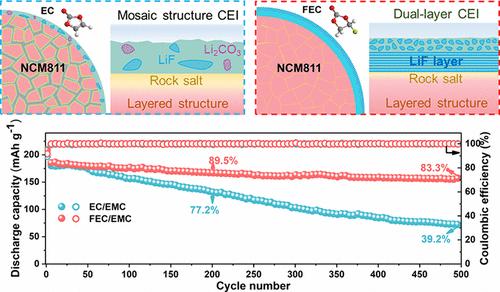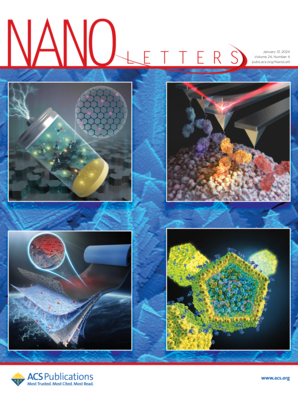Cathode–Electrolyte Interphase of Ni-Rich Layered Oxides: Evolving Structure and Implication on Stability
IF 9.6
1区 材料科学
Q1 CHEMISTRY, MULTIDISCIPLINARY
引用次数: 0
Abstract
The cathode–electrolyte interphase (CEI) is recognized as a crucial component in battery systems; however, knowledge regarding its structure and function remains limited and often controversial. This study demonstrates the feasibility of revealing atomic-resolution CEI structures via cryogenic transmission electron microscopy (cryo-TEM). Using Ni-rich oxide (LiNi0.8Co0.1Mn0.1O2, NCM811) microparticles as the model cathode, ultrafine images of CEI were obtained, revealing its dynamic evolution over cycling and its impact on battery performance. In ethylene carbonate (EC)-based electrolytes, the CEI forms an amorphous organic-rich layer, while, in fluoroethylene carbonate (FEC)-based electrolytes, the CEI contains abundant LiF grains. Both CEIs thicken with cycling but exhibit different structural evolutions: the former adopts a mosaic structure, while the latter forms a dual-layer structure with a compact LiF inner layer. These unprecedented high-resolution images and comprehensive analysis advance the understanding of CEI dynamics, addressing existing controversies and providing insights for improving battery performance.

求助全文
约1分钟内获得全文
求助全文
来源期刊

Nano Letters
工程技术-材料科学:综合
CiteScore
16.80
自引率
2.80%
发文量
1182
审稿时长
1.4 months
期刊介绍:
Nano Letters serves as a dynamic platform for promptly disseminating original results in fundamental, applied, and emerging research across all facets of nanoscience and nanotechnology. A pivotal criterion for inclusion within Nano Letters is the convergence of at least two different areas or disciplines, ensuring a rich interdisciplinary scope. The journal is dedicated to fostering exploration in diverse areas, including:
- Experimental and theoretical findings on physical, chemical, and biological phenomena at the nanoscale
- Synthesis, characterization, and processing of organic, inorganic, polymer, and hybrid nanomaterials through physical, chemical, and biological methodologies
- Modeling and simulation of synthetic, assembly, and interaction processes
- Realization of integrated nanostructures and nano-engineered devices exhibiting advanced performance
- Applications of nanoscale materials in living and environmental systems
Nano Letters is committed to advancing and showcasing groundbreaking research that intersects various domains, fostering innovation and collaboration in the ever-evolving field of nanoscience and nanotechnology.
 求助内容:
求助内容: 应助结果提醒方式:
应助结果提醒方式:


